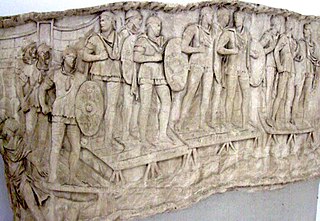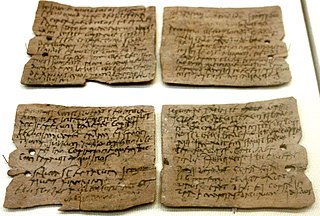Related Research Articles

Vindolanda was a Roman auxiliary fort (castrum) just south of Hadrian's Wall in northern England, which it pre-dated. Archaeological excavations of the site show it was under Roman occupation from roughly 85 AD to 370 AD. Located near the modern village of Bardon Mill in Northumberland, it guarded the Stanegate, the Roman road from the River Tyne to the Solway Firth. It is noted for the Vindolanda tablets, a set of wooden leaf-tablets that were, at the time of their discovery, the oldest surviving handwritten documents in Britain.

The Revolt of the Batavi took place in the Roman province of Germania Inferior between AD 69 and 70. It was an uprising against the Roman Empire started by the Batavi, a small but militarily powerful Germanic tribe that inhabited Batavia, on the delta of the river Rhine. They were soon joined by the Celtic tribes from Gallia Belgica and some Germanic tribes.

The Tungri were a tribe, or group of tribes, who lived in the Belgic part of Gaul, during the times of the Roman Empire. Within the Roman Empire, their territory was called the Civitas Tungrorum. They were described by Tacitus as being the same people who were first called "Germani" (Germanic), meaning that all other tribes who were later referred to this way, including those in Germania east of the river Rhine, were named after them. More specifically, Tacitus was thereby equating the Tungri with the "Germani Cisrhenani" described generations earlier by Julius Caesar. Their name is the source of several place names in Belgium, Germany and the Netherlands, including Tongeren, Tongerlo Abbey, and Tongelre.

The Roman army was the armed forces deployed by the Romans throughout the duration of Ancient Rome, from the Roman Kingdom to the Roman Republic and the Roman Empire, and its medieval continuation, the Eastern Roman Empire. It is thus a term that may span approximately 2,206 years, during which the Roman armed forces underwent numerous permutations in size, composition, organisation, equipment and tactics, while conserving a core of lasting traditions.

Housesteads Roman Fort was an auxiliary fort on Hadrian's Wall, at Housesteads, Northumberland, England. It is dramatically positioned on the end of the mile-long crag of the Whin Sill over which the Wall runs, overlooking sparsely populated hills. It was called the "grandest station" on the Wall and is one of the best-preserved and extensively displayed forts. It was occupied for almost 300 years. It was located 5.3 miles west from Carrawburgh fort, 6 miles east of Great Chesters fort and about two miles north east of the existing fort at Vindolanda on the Stanegate road.

The auxilia were introduced as non-citizen troops attached to the citizen legions by Augustus after his reorganisation of the Imperial Roman army from 27 BC. By the 2nd century, the Auxilia contained the same number of infantry as the legions and, in addition, provided almost all of the Roman army's cavalry and more specialised troops. The auxilia thus represented three-fifths of Rome's regular land forces at that time. Like their legionary counterparts, auxiliary recruits were mostly volunteers, not conscripts.
Laeti, the plural form of laetus, was a term used in the late Roman Empire to denote communities of barbari ("barbarians"), i.e. foreigners, or people from outside the Empire, permitted to settle on, and granted land in, imperial territory on condition that they provide recruits for the Roman military. The term laetus is of uncertain origin. It means "lucky" or "happy" in Latin, but may derive from a non-Latin word. It may derive from a Germanic word meaning "serf" or "half-free colonist". Other authorities suggest the term was of Celtic or Iranian origin.

Magnis or Magna was a Roman fort near Hadrian's Wall in northern Britain. Its ruins are now known as Carvoran Roman Fort and are located near Carvoran, Northumberland, in northern England. It was built on the Stanegate frontier and Roman road, linking Coria (Corbridge) in the east to Luguvalium (Carlisle) in the west, before the building of Hadrian's Wall.

The Vindolanda tablets were, at the time of their discovery, the oldest surviving handwritten documents in Britain. They are a rich source of information about life on the northern frontier of Roman Britain. Written on fragments of thin, postcard-sized wooden leaf-tablets with carbon-based ink, the tablets date to the 1st and 2nd centuries AD. Although similar records on papyrus were known from elsewhere in the Roman Empire, wooden tablets with ink text had not been recovered until 1973, when archaeologist Robin Birley, his attention being drawn by student excavator Keith Liddell, discovered some at the site of Vindolanda, a Roman fort in northern England.
Luguvalium was an ancient Roman city in northern Britain located within present-day Carlisle, Cumbria, and may have been the capital of the 4th-century province of Valentia. It was the northernmost city of the Roman Empire.

In modern scholarship, the "late" period of the Roman army begins with the accession of the Emperor Diocletian in AD 284, and ends in 480 with the death of Julius Nepos, being roughly coterminous with the Dominate. During the period 395–476, the army of the Roman Empire's western half progressively disintegrated, while its counterpart in the East, known as the East Roman army remained largely intact in size and structure until the reign of Justinian I.
Cohors quarta Gallorum equitata was a Roman auxiliary cohort containing both infantry and cavalry contingents.

The Alpine regiments of the Roman army were those auxiliary units of the army that were originally raised in the Alpine provinces of the Roman Empire: Tres Alpes, Raetia and Noricum. All these regions were inhabited by predominantly Rhaetian peoples and Celtic-speaking tribes. They were annexed, or at least occupied, by the emperor Augustus' forces during the period 25–14 BC. The term "Alpine" is used geographically in this context and does not necessarily imply that the regiments in question were specialised in mountain warfare. However, in the Julio-Claudian period, when the regiments were still largely composed of Alpine recruits, it is likely that they were especially adept at mountain operations.

This article concerns the Roman auxiliary regiments of the Principate period originally recruited in the western Alpine regions of the empire. The cohortes Alpinorum came from Tres Alpes, the three small Roman provinces of the western Alps, Alpes Maritimae, Alpes Cottiae and Alpes Graiae. The cohortes Ligurum were originally raised from the Ligures people of Alpes Maritimae and Liguria regio of NW Italia.

Uxelodunum was a Roman fort with associated civilian settlement (vicus) in modern-day Carlisle, Cumbria, England. It was the largest fort on Hadrian's Wall and is now buried beneath the suburb of Stanwix.

The equites singulares Augusti or equites singulares Imperatoris were the cavalry arm of the Praetorian Guard during the Principate period of imperial Rome. Based in Rome, they escorted the Roman emperor whenever he left the city on a campaign or on tours of the provinces. The equites singulares Augusti were a highly trained unit dedicated to protecting the emperor. Men who served in the equites singulares Augusti held a Roman public status as equites.

The Imperial Roman Army was the military land force of the Roman Empire from 27 BC to 476 AD, and the final incarnation in the long history of the Roman army. This period is sometimes split into the Principate and the Dominate (284–476) periods.

The Batavi was an auxilia palatina (infantry) unit of the late Roman army, active between the 4th and the 5th century. It was composed by 500 soldiers and was the heir of those ethnic groups that were initially used as auxiliary units of the Roman army and later integrated in the Roman Empire after the Constitutio Antoniniana. Their name was derived from the people of the Batavi.
Cohors PrimÆ Ælia Dacorvm was an infantry regiment of the Auxilia corps of the Imperial Roman army. It was first raised by the Roman emperor Hadrian in the Roman province of Dacia not later than AD 125 and its last surviving record dates c. 400. It was deployed, for virtually its entire history, in forts on Hadrian's Wall on the northern frontier of Britannia province.
References
- ↑ D. Mattingly An imperial possession: Britain in the Roman empire (2006) 131
- ↑ http://www.roman-britain.co.uk List of auxiliary units in Britain (external link below)
- ↑ Auxiliary unit figures from Paul Holder: Auxiliary deployment in the reign of Hadrian, in: J.J. Wilkes (ed.): Documenting the Roman Army. Essays in honour of Margaret Roxan, London 2003, p. 101-146, here 145.
- ↑ Mattingly op cit 168-9
- ↑ Vindolanda Tablet 154
- ↑ Mattingly op cit 162-5
- ↑ Vindolanda Tablet 346
- ↑ Vindolanda Tablet 164
- ↑ Holder (2003) 145